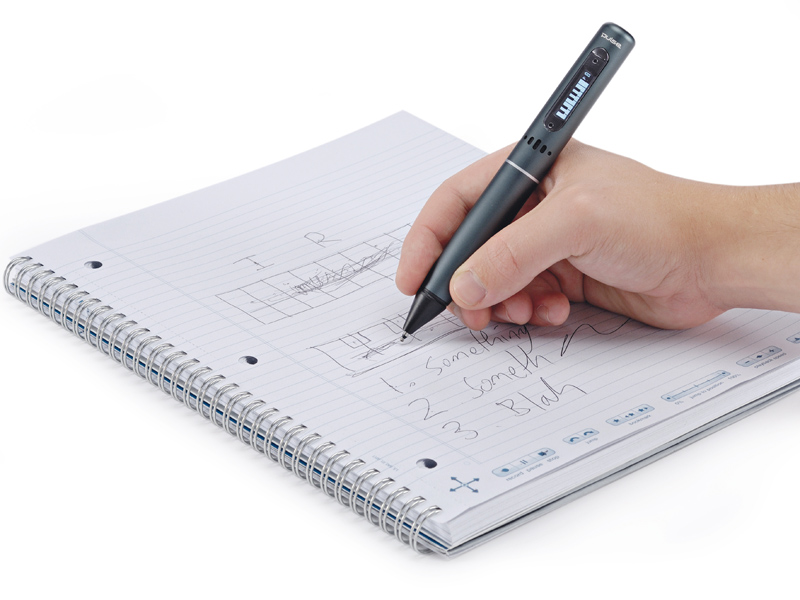TechRadar Verdict
A useful little gadget but one we can help feel is over priced for it's target market
Pros
- +
Live note-taking
- +
Playback
- +
Built-in computing functions
- +
Online application store
- +
Free booklet of dot paper
Cons
- -
Expensive
- -
OCR costs more
Why you can trust TechRadar
The Pulse pen might look like one of those silly portable scanners, but it's not. It's far more interesting than any previous attempt to bridge the gap between paper and screen, and it all starts when you draw a piano.
Draw nine vertical lines from left to right, two horizontals above and below, scribble a couple of letters as controls and start playing.
Tap a newly drawn key and it plays a note. Tap elsewhere and it adds a drumbeat. Run the pen across the piano's surface and you can play some pretty music. It's very impressive stuff, and it's made possible by sheets of special notepaper, a camera in the end of the pen and a computer tucked away inside to do the heavy lifting.
Of course, drawing pianos isn't really what the Pulse is for – it's just a fun demo of what it's capable of. It's mainly a recording device, but one with a phenomenal amount of flexibility. Tap the Record button and begin writing, and as well as keeping track of what you're scribbling on the paper, it records the audio around you.
Come back to it later and you don't just get to replay the whole thing, but you can tap on a sentence in your written notes to play the audio from that point.
Plug the Pulse into your PC and you can watch your notes gradually build up on-screen, synchronised with the audio, or skip to the relevant bit. It's perfect for making sure you don't miss anything, or for clarifying an illegible note.
Unfortunately, it's not as easy as just grabbing a bit of scrap paper and starting to write. You have to use special 'dot paper' printed with microdots so that the pen knows both where it is and what page you're on.
You get one (deeply unattractive) book with the pen, with better looking ones available online for between £13 and £20. That's a bit pricey, but it's not as bad as it sounds – you can print as many sheets as you want as long as you have access to a printer that handles Postscript.
The pen can hold four books in memory at once, with others downloaded to a PC via the combined dock/charger.
As for the more mundane question of ink, it requires custom refills. One spare cartridge is supplied in the box, along with an interchangeable stylus.
Word for word
The note-taking part of the pen works well, although, as with all recording equipment, it's best in a small room with clear voices. Air conditioning, chairs scraping or voices not carrying across a large space will all conspire to make the result tough to hear.
What makes it more interesting is that you're not limited to just its current functions – an iTunes-style store is being added to handle far more complicated tasks such as OCR, or gimmicks including a guitar to go with the piano.
A couple of examples of what it can do come on the unit itself, most impressively the 'Translator Demo' – write a word and the pen reads it back in the language of your choice (although in practice it only recognised a few of them and the responses are pre-recorded rather than done with text-to-speech).
Whether the device takes off or not, it's not difficult to see its possibilities. The Pulse pen is a very impressive piece of technology, and definitely a good way to show off in a meeting or lecture theatre.
It's just a shame that it can't do its remarkable tricks on regular paper, ridding us of the need for magic dots and ugly notebooks.
The Livescribe Pulse Smartpen comes in two parts: the pen and the software.
The pen is slightly too large for comfort, but not exceptionally so, with only one button, an LCD screen and a microphone jack to worry about.
The built-in recording is good for a small device, but it's worth doing a quick sound check in a new room before scribbling away.
The only odd thing is that the dock is designed to hold the pen horizontally instead of vertically, as if it was placed in an old-style inkwell.
On the PC, the client works very well. It's particularly good at using the data on the pen, searching for words and exporting notes as animated flash movies. Annoyingly though, if you want OCR (which seems like a no-brainer on a tool for note-taking), it'll cost another $30 (about £18) on top of the already pricey unit.
It's a powerful performer and £138 isn't a ridiculous amount of money for the flexibility you get, but it's a lot to ask for what is, at heart, a pen – particularly for hard-up students.
Follow TechRadar Reviews on Twitter: http://twitter.com/techradarreview
